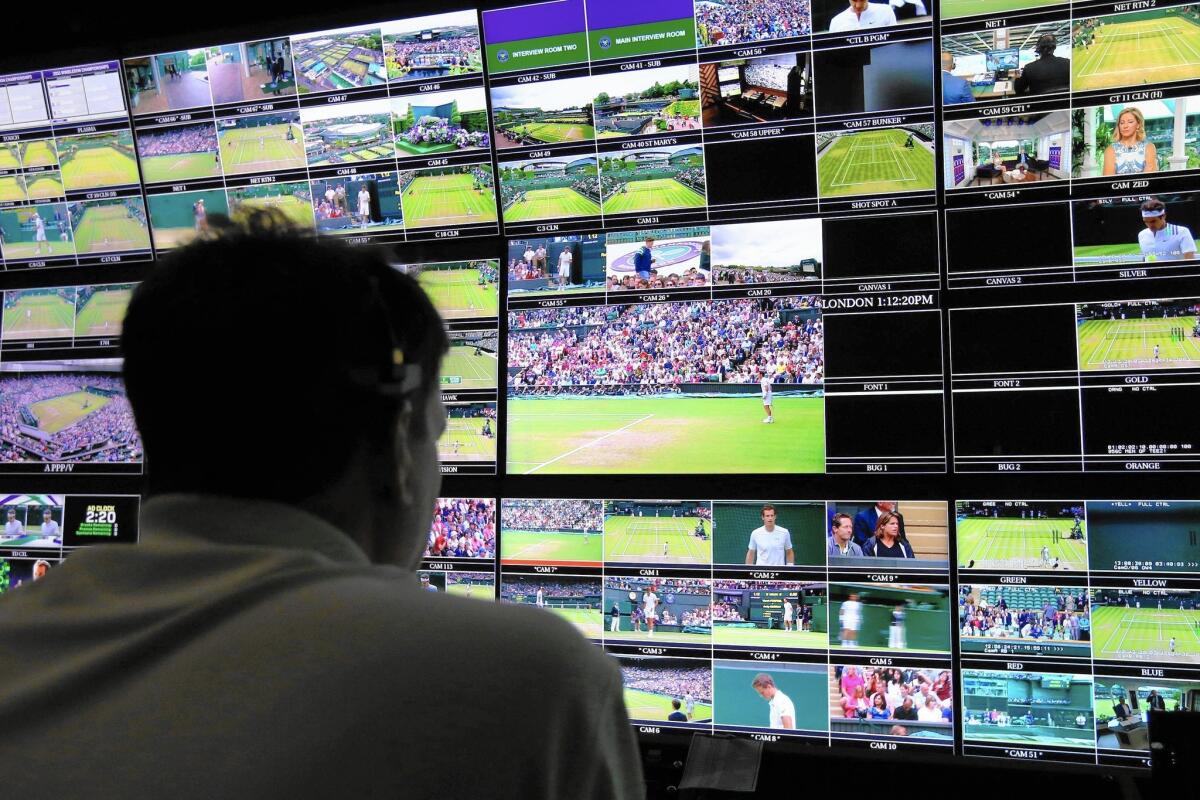Disney earnings soar 11%, but changes in TV industry pose risks

- Share via
Walt Disney Co. set a record for profit in its most recent fiscal quarter but warned that dramatic changes in the television landscape could eat into earnings.
The Burbank company reported net income of $2.48 billion in the third quarter that ended June 27, up 11% from a year earlier. Revenue rose 5% to $13.1 billion.
But the world’s largest entertainment firm telegraphed to Wall Street on Tuesday that an increasingly fragmented television business could be a drag on cable TV profits, which for years have been a major driver for Disney’s financial performance.
Stunning photos, celebrity homes: Get the free weekly Hot Property newsletter >>
The crown jewel of Disney’s television business is ESPN, which commands the highest rates from pay-TV operators seeking to offer it to their customers.
Still, some consumers’ move away from expensive cable television bundles and embrace of new avenues for consuming content are starting to erode operators’ subscriber bases. A growing number of Americans are turning to streamlined TV packages that offer fewer channels, and others are embracing streaming services such as Netflix and Amazon Instant Video.
“We’re realists about the business and about the impact technology has had on how product is distributed, marketed and consumed,” Disney Chairman and Chief Executive Robert Iger said in a conference call with analysts. “We’re also quite mindful of potential trends among younger audiences in particular, many of whom consume television in very different ways than the generations before them.”
For years, nearly 100 million homes in the U.S. subscribed to a pay-TV service, via either a cable, satellite or telephone company. Now these operators are offering slimmed-down packages, which hurts Disney because the company has long relied on having ESPN and other premium channels such as ABC Family distributed to nearly all the pay-TV homes. Analysts have estimated that over the last few years, about 3 million fewer homes pay for all of the channels including ESPN.
But any erosion is expected to be modest. Last year, Disney forecast that its cable business’ operating income would grow by “high single digits” on a compounded annual basis from 2013 to 2016. Now, Iger said, it is expected to grow in the “mid single digits” range, in part because of “slightly less subscribers,” including some at ESPN.
The lowered forecast comes as Disney faces higher costs at ESPN. In part because of increased competition, the network has seen a dramatic escalation in the licensing fees it pays to broadcast marquee NFL, MLB and NBA games. Starting last year, ESPN’s rights payments to the NFL for “Monday Night Football” jumped from $1.1 billion to $1.9 billion per season.
Shares of Disney closed at $121.74, up less than 1%. But as Disney executives discussed the company’s lower economic guidance, investors sent the stock down more than $7 after hours, or about 6%.
“It is a concern — it takes a little of the icing off of the cake,” said analyst Robin Diedrich of Edward Jones Research. “But we think there are certainly more positives here than negatives, unless subscriber losses get out of control or out of whack with what we’d expect.”
Indeed, Disney delivered earnings per share of $1.45, beating analysts’ estimates of $1.42. And despite the lower forecast, Disney’s media networks division — which includes the company’s cable TV unit — delivered strong results. The unit produced operating income of $2.38 billion, up 4%. The company said results at ESPN were driven by growth in affiliate revenue, which was partially offset by lower advertising revenue.
Disney’s studio division produced operating income of $472 million, up 15% from a year ago. The group’s performance was buoyed by “Avengers: Age of Ultron,” the Marvel superhero picture that grossed $1.4 billion worldwide since hitting theaters May 1. That offset the performance of “Tomorrowland,” a George Clooney film that was not well received by critics and performed poorly.
Disney did not disclose how much money it lost on “Tomorrowland,” which was released May 22 and has taken in $208 million at the box office. It had an estimated budget of $190 million and cost tens of millions of dollars more to market. Reports have indicated that Disney could lose as much as $140 million on the Brad Bird-directed science fiction film.
Analysts are already looking forward to the December release of “Star Wars: The Force Awakens,” which will be the first new film in the franchise in more than a decade and an expected financial juggernaut for the studio. But as Iger described “Star Wars” as “probably the most valuable film franchise that ever existed,” he espoused a measure of caution.
“While the enthusiasm is I think rather apparent, we just want to be careful that the world doesn’t get ahead of us too much in terms of the estimates,” he said.
Although four of Disney’s five operating segments generated profit during the quarter, the company’s interactive division broke even. It had produced operating income of $29 million a year ago. Disney attributed the decrease to “lower results” from “Disney Infinity,” the company’s action-adventure video game.
Disney executives also used the call with analysts to discuss the expected effect of foreign currency exchange rates on fiscal 2016 operating income. Christine McCarthy, who was named chief financial officer in June, said the strength of the U.S. dollar versus “a number of key foreign currencies” is expected to lower operating income in the next fiscal year by about $500 million.
Jason Moser, an analyst with the Motley Fool, said he was not concerned by the announcement.
“We tend to look at foreign currency issues as not wholly material in the long run, because you see it fluctuate both ways,” he said.
Even as Iger discussed the lowered forecast for the TV business, he touted the value of Disney’s programming, calling ESPN “among the most popular respected and valuable brands in media.” For example, Dish Network made sure that its recently launched Internet-delivered Sling TV service would include both ESPN and ESPN2 as primary channels.
In addition, Disney cut a lucrative deal to supply Netflix with TV shows featuring Marvel characters including Daredevil.
“We’re going to take advantage of opportunities,” Iger said. “It’s just hard to … say when something either feels too disruptive too fast or not.”
The strength of the company’s television offerings allows it to chart a more cautious path than other media firms looking to find new beachheads in a rapidly changing business environment, Diedrich said.
“They can afford to be more cautious because their content in most categories is the leading brand or pretty close to it,” she said. “They have better leverage than most.”
MORE FROM DISNEY:
How Robert Iger’s ‘fearless’ deal-making transformed Disney
How ‘Chinese’ will Shanghai Disney be?
Walt Disney Co. earnings: 5 things to know
More to Read
From the Oscars to the Emmys.
Get the Envelope newsletter for exclusive awards season coverage, behind-the-scenes stories from the Envelope podcast and columnist Glenn Whipp’s must-read analysis.
You may occasionally receive promotional content from the Los Angeles Times.












